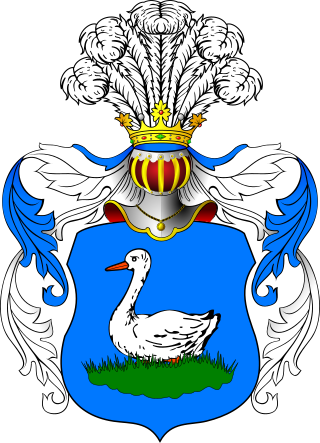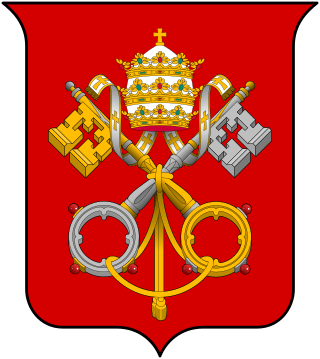Related Research Articles

A coat of arms is a heraldic visual design on an escutcheon, surcoat, or tabard. The coat of arms on an escutcheon forms the central element of the full heraldic achievement, which in its whole consists of a shield, supporters, a crest, and a motto. A coat of arms is traditionally unique to the armiger. The term 'coat of arms' itself, describing in modern times just the heraldic design, originates from the description of the entire medieval chainmail 'surcoat' garment used in combat or preparation for the latter.
This armorial of sovereign states shows the coat of arms, national emblem, or seal for every sovereign state. Although some countries do not have an official national emblem, unofficial emblems which are de facto used as national emblems are also shown below.

Ossorya is a Polish coat of arms. It was used by several szlachta families in the times of the Polish–Lithuanian Commonwealth.

Zagłoba is a Polish coat of arms. It was used by several noble families in the times of the Polish–Lithuanian Commonwealth.

Mogiła is a Polish coat of arms. It was used by a number of szlachta (noble) families under the Polish–Lithuanian Commonwealth.

Hełm is a Polish coat of arms. It was used by a number of szlachta (noble) families under the Polish–Lithuanian Commonwealth.

Przegonia is a Polish coat of arms. It was used by several szlachta families in the times of the Polish–Lithuanian Commonwealth.
The Naval Crown was a gold crown surmounted with small replicas of the prows of ships. It was a Roman military award, given to the first man who boarded an enemy ship during a naval engagement.

The umbraculum is a historic piece of the papal regalia and insignia, once used on a daily basis to provide shade for the pope. Also known as the pavilion, in modern usage the umbraculum is a symbol of the Catholic Church and the authority of the pope over it. It is found in the contemporary Church at all the basilicas throughout the world, placed prominently at the right of their main altars. Whenever the pope visits a basilica, its umbraculum is opened.
Papal coats of arms are the personal coat of arms of popes of the Catholic Church. These have been a tradition since the Late Middle Ages, and has displayed his own, initially that of his family, and thus not unique to himself alone, but in some cases composed by him with symbols referring to his past or his aspirations. This personal coat of arms coexists with that of the Holy See.

A mural crown is a crown or headpiece representing city walls, towers, or fortresses. In classical antiquity, it was an emblem of tutelary deities who watched over a city, and among the Romans a military decoration. Later the mural crown developed into a symbol of European heraldry, mostly for cities and towns, and in the 19th and 20th centuries was used in some republican heraldry.

The personal papal coat of arms of Pope Benedict XVI was designed by Archbishop Andrea Cordero Lanza di Montezemolo soon after the papal election in 2005.

Bruno Bernard Heim was a Swiss prelate and Latin Titular Archbishop of Xanthus, a long-serving diplomat of the Holy See who among other appointments was Apostolic Delegate to Great Britain, and later Apostolic Pro-Nuncio, and eventually Apostolic Nuncio, serving until his retirement as a diplomat in 1985.
The uses of heraldry in Belarus is used by government bodies, subdivisions of the national government, organizations, corporations and by families.

Ecclesiastical heraldry refers to the use of heraldry within Christianity for dioceses, organisations and Christian clergy. Initially used to mark documents, ecclesiastical heraldry evolved as a system for identifying people and dioceses. It is most formalized within the Catholic Church, where most bishops, including the Pope, have a personal coat of arms. Clergy in Anglican, Lutheran, Eastern Catholic and Eastern Orthodox churches follow similar customs, as do institutions such as schools and dioceses.

Gąska is a Polish coat of arms. It was used by several szlachta families in the times of the Polish–Lithuanian Commonwealth.

In heraldry, crows and ravens are not distinguished from each other. A crow or raven is usually depicted with hairy feathers and closed wings. A crow speaking will have its mouth agape or open as if it were speaking. Crows may also be called corbies, as in the canting arms of Corbet, c. 1312.

The coats of arms of the Holy See are the forms that combines two crossed keys and a tiara used as a coat of arms of the Holy See. These forms have origins attested from the 14th century. The combination of one gold and one silver key is a somewhat later development.
In heraldry, copper is the tincture of metallic copper. Copper has been introduced in Canadian heraldry. It is considered a metal along with Argent (silver) and Or (gold) and should be depicted as bright, new copper metal.

Civic heraldry is heraldry used by municipalities.
References
- ↑ Friar, Stephen, ed. (1987). A New Dictionary of Heraldry. London: Alphabooks/A&C Black. p. 285. ISBN 0-906670-44-6.